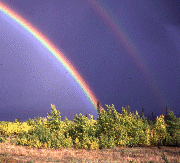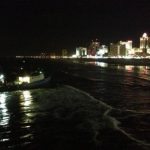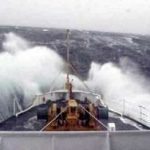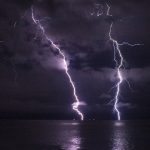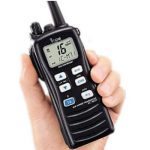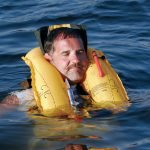Boating safety experts will encourage you to learn as much as you can about weather. And with justification. “Weather” is the earth’s atmosphere trying to find equilibrium, and it’s been attempting to do so from the beginning of time. The sun heats up the air in one place, the warmed air rises, colder air rushes in to fill the space created by its departure, other air flows in to take the place of the colder air, and on and on. The degree to which the elements respond to each other make the difference between a mild, sunny day with a light breeze, and “the perfect storm.” So, as a boater exposed to those elements, if you can spot trouble, it’s a step in the direction of safety.
The recreational boater doesn’t have to be a meteorologist, however, to safely enjoy a great day on the water, a cruise with the family or even a transatlantic crossing. Although you might encounter an occasional storm while on the water, you also will find that the skies are filled with wonder. The more you know about the phenomena that accompany the changing weather patterns around you, the more you’ll appreciate the beauty and splendor just overhead.
For example, what sailor has not been transfixed by the awesome spectacle of “Jacob’s ladder”? These crepuscular rays, as scientist refer to them, shine through breaks in the clouds on or from just below the horizon, creating an optical effect sometimes described as “the sun drawing water.” The light pillars resulting from the sun breaking through some distant clouds into an illuminated atmosphere provide a display that can put a perfect ending on a perfect day.
One phenomenon, called a “superior mirage,” has been known to startle even the most experienced seafarers. The name doesn’t refer to the quality of the mirage, but rather to a ghostly apparition formed above its real position. Ships on the horizon appear to be floating in air, upside down, no less. If you know that the mirage is caused by low-level temperature inversions, such as warm air flowing over cold water, then you can just sit back and watch the show. In days of yore, however, tense sailors who didn’t have the benefit of science to explain these phenomena labeled the apparitions “ghost ships.”
Rainbows always are cause for pulling back the throttles and reaching for the camera. For centuries, skippers have regaled their passengers with tales of treasure at the foot of the rainbow, and to this day children are told of the pot of gold that lies in wait for the lucky stiff that finds the rainbow’s end. But it’s the lucky sailor that is able to sit beneath a “double rainbow,” concentric arcs of brilliance that burst across the sky, one above the other, each with colors reversed. Meteorologists would call the outer rainbow a “secondary” rainbow, but to you and I on a warm, sunny day on the water, it would just be called “magnificent.”
There are many other examples of natural aerial phenomena now showing at a sky near you — Sprites, Elves, coronas, sundogs, diamond dust, St. Elmo’s fire, ball lightning, lunar rainbows, blue jets, irisation, and the green flash. The advantage to the boater, of course, is the huge, unobstructed “supermax” panoramic view available to us from the deck of our floating theater.
Some of the dishes that Mother Nature cooks up for us are not as digestible as those mentioned above. Those beautiful, massive, towering cumulus clouds we see filling the skies in mid-summer may very well be harboring a dangerous storm cell. That breathtaking red sky in the morning (sailor take warning) might be telling us to batten the hatches. But most of the atmospheric displays experienced by boaters seem to be there just to remind us how small our tiny little boats — and we — really are. And when we get a bit cocky and start taking risks on the water, a tap on the shoulder by Mother is not such a bad thing.
Knowing about weather — forecasting, patterns and phenomenon — is just part of being a complete boater. Not only can it help you avoid trouble, but it can give you an appreciation for the natural beauty of the skies, and the infinite variety of phenomenal events that take place just over our heads every day and every night. Whether it’s Mother Nature or weather, you’ll have more fun and increase your level of boating safety by knowing more about what you see when you tilt your head skyward.

